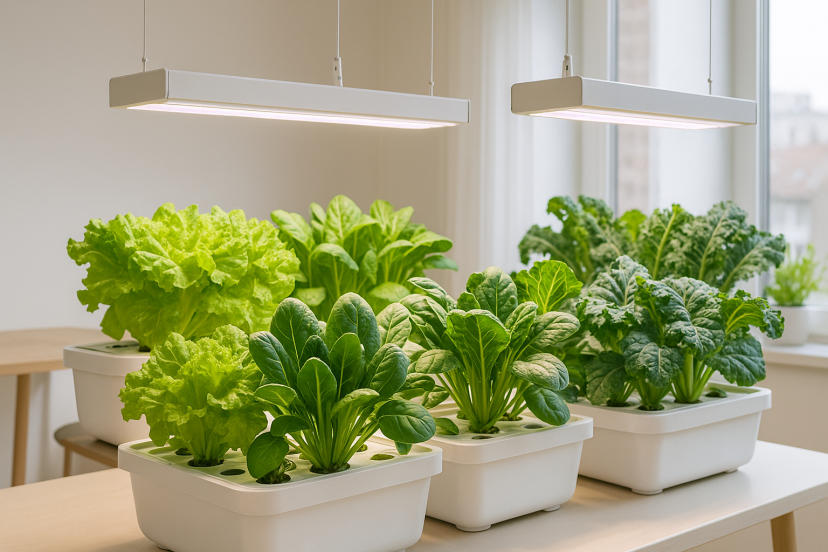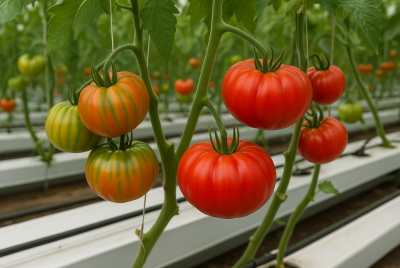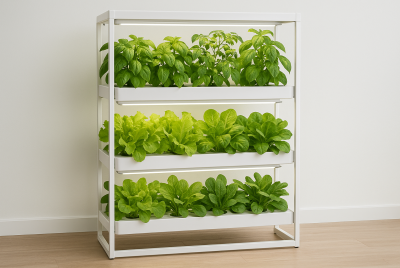Winter Hardy Plants: 5 Leafy Greens to Grow Hydroponically Indoors
We may earn a commission for purchases made using our links. Please see our disclosure for more details.
Winter can feel like the end of fresh produce. Outdoor gardens shut down, the soil freezes, and what’s left in grocery stores rarely compares to something you’ve picked yourself. Most of the time, the greens you buy are either overpriced or already past their prime. That’s why many growers turn to Winter Hardy Plants in hydroponic systems. By bringing the garden indoors, you can keep leafy greens like lettuce, spinach, and kale thriving even when it’s freezing outside. Hydroponics makes it possible to enjoy a steady harvest all season—without depending on the weather.
Why Leafy Greens Are Ideal for Winter Hydroponics
Year-Round Harvests
Unlike fruiting plants that require long daylight hours, leafy greens thrive under artificial lighting. This makes them perfect for winter cultivation when outdoor conditions are less than ideal. Even in January, you can walk into your indoor garden and pick crisp, vibrant greens.
Fast Growth and Continuous Harvesting
Many leafy greens mature quickly, often within 30 to 45 days. Better yet, you don’t need to wait for the entire plant to mature. By harvesting outer leaves, you encourage fresh growth while keeping your system productive.
Adaptable Growing Systems
Whether you’re experimenting with Deep Water Culture (DWC), Nutrient Film Technique (NFT), or even a simple Kratky setup, leafy greens adapt beautifully. For best results, ensure a steady oxygen supply with a quality hydroponics pump.
Low Maintenance Compared to Fruiting Plants
Tomatoes, peppers, and cucumbers often need heavy nutrient input and strict care. Leafy greens, on the other hand, are far less demanding. With basic lighting, balanced nutrients, and consistent water flow, they’ll thrive in almost any indoor space.
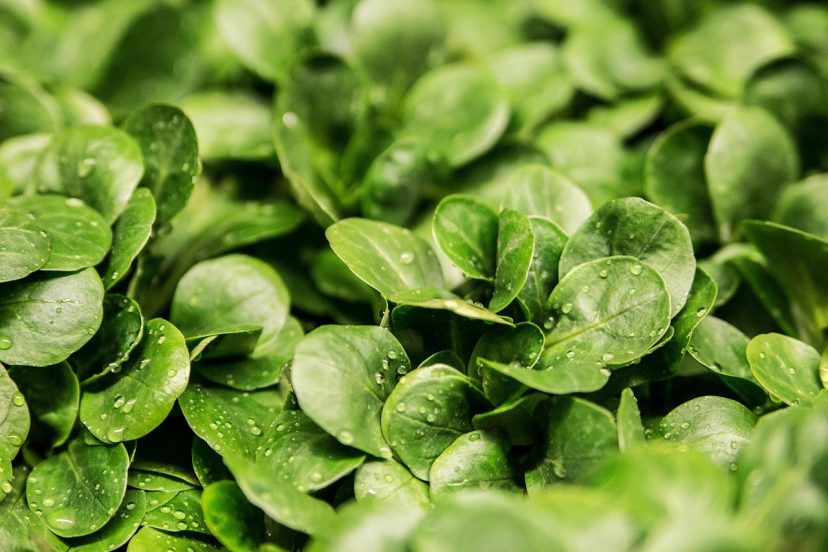
The Top 5 Winter Hardy Leafy Greens for Hydroponics
1. Lettuce – The Hydroponic Classic
Lettuce ranks among the simplest Winter Hardy Plants to raise in a hydroponic system. It matures quickly, takes up very little space, and adapts well to almost any indoor system. You can harvest leaves continuously instead of waiting for a full head, which keeps salads fresh all season. Butterhead, Romaine, and Leaf lettuce are popular choices, thriving when water is kept between 65–70°F. Mixing different varieties together even creates a colorful, ready-to-pick salad bowl at home.
2. Spinach – A Winter Superfood
Spinach is a cold-weather favorite and an excellent match for hydroponic systems. It thrives in cooler temperatures, making it perfect for indoor setups during the winter months. Packed with iron, magnesium, and vitamins A, C, and K, spinach grows best in slightly acidic conditions with a pH around 6.0–6.5. Harvesting the leaves when they reach 3–4 inches encourages new growth, and the steady supply makes it a reliable choice for nutrient-rich winter meals.
3. Kale – A Nutrient-Dense Powerhouse
Kale is one of the toughest and most rewarding greens to grow indoors. It thrives under strong light and cooler conditions, tolerating low winter temperatures with ease. Regularly harvesting the outer leaves keeps the plants producing for months, and both Curly and Lacinato (Dinosaur) kale offer excellent flavor and texture. With its impressive levels of vitamins and antioxidants, kale is a must-have for anyone looking to grow superfoods hydroponically through the colder months.
4. Swiss Chard – Beauty Meets Function
Swiss chard brings both beauty and productivity to an indoor hydroponic garden. Its colorful stems brighten up any growing space, while its leafy greens deliver antioxidants, fiber, and vitamins. Chard adapts well to most hydroponic systems, especially NFT and DWC, when provided with 10–12 hours of light each day. It’s also versatile in the kitchen—great raw in salads, lightly sautéed as a side, or added to hearty winter soups.
5. Bok Choy – Quick and Reliable
Bok choy, also known as pak choi, is one of the fastest-growing leafy greens you can grow indoors, often ready for harvest in just 30 days. With shallow roots and a compact size, it fits perfectly into hydroponic setups and produces tender, mild-flavored leaves that work well in stir-fries, soups, and fresh salads. Its quick growth cycle makes it especially valuable in the winter months, when you want fast and reliable harvests.
Why These Greens Stand Out for Winter Hydroponics
- Year-Round Harvests – No seasonal interruptions; you’ll enjoy constant supplies.
- Quick Turnaround – Many of these greens are ready within weeks, not months.
- Nutrient Density – Each crop is packed with vitamins, minerals, and antioxidants.
- Space-Saving Growth – Shallow root systems make them perfect for compact systems.
- Beginner-Friendly – They thrive with minimal care, making them ideal for new growers.
Must-Have Hydroponic Tools and Kits
To maximize your indoor garden’s success, here are some top-rated tools and kits:
- AeroGarden Harvest Indoor Hydroponic Garden – Great for beginners with automated lighting and reminders.
- Hydrofarm Active Aqua Air Pump – Ensures steady oxygenation for healthy root growth.
- General Hydroponics Flora Series Nutrient Kit – Complete nutrient solution designed for leafy greens.
- iDOO Hydroponics Growing System – Compact indoor garden that fits on a kitchen counter.
- VIVOSUN DWC Hydroponic Bucket System – Reliable choice for larger setups and continuous growth.
What the Research Says
Studies confirm the value for nutrition and sustainability of hydroponics, not just convenience. A Horticulturae study on nutrient solution temperature in hydroponics found that carefully managing water in systems like Deep Water Culture can significantly improve the growth and yield of leafy greens such as lettuce and pak choi, proving how environmental control helps plants thrive even in colder months. Similarly, a Sustainability review comparing hydroponic and conventional greenhouse farming revealed that hydroponic systems can deliver up to 11 times higher yields while using fewer resources like water and energy, making the method both efficient and environmentally friendly. Together, these findings show that growing Winter Hardy Plants indoors with hydroponics is practical, sustainable, and a reliable way to enjoy consistent harvests year-round.
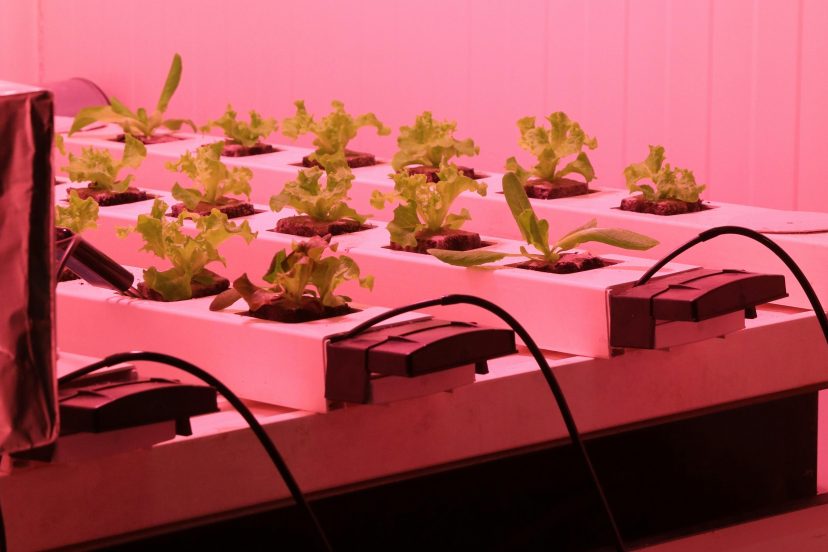
Practical Tips for Winter Hydroponic Success
- Lighting: Invest in full-spectrum LED grow lights that mimic natural sunlight.
- Temperature Control: Keep water temperatures between 65–72°F for leafy greens.
- pH Balance: Monitor pH levels regularly; leafy greens thrive between 5.8–6.5.
- Air Circulation: Use small fans to prevent mold and mildew.
- Nutrient Monitoring: Top up reservoirs and refresh solutions every two weeks for best growth.
These small adjustments can make a huge difference in ensuring steady winter harvests.
Conclusion
If you’re planning to grow winter hardy plants indoors, lettuce, spinach, kale, Swiss chard, and bok choy make some of the best options. They grow quickly, require little upkeep, and provide a steady supply of nutrient-rich greens. For beginners, they offer an easy way to get started, while experienced growers will appreciate how reliable they are for year-round harvests. With the right hydroponic setup, you can leave behind the limp produce at the supermarket and enjoy crisp, fresh greens straight from your own home.
FAQs
1. What are the easiest winter hardy plants for hydroponics?
Lettuce and spinach are the easiest to start with, requiring minimal care.
2. How frequently should the nutrient solution be replaced?
Every two weeks is ideal, though topping up with fresh water in between helps maintain balance.
3. Can I grow multiple leafy greens together?
Yes! Mixing varieties in the same system works well as long as they share similar nutrient needs.
4. Do I need a large space for hydroponic gardening?
Not at all. Countertop systems can grow multiple plants in less than two square feet.
5. Are hydroponically grown greens as healthy as soil-grown?
Yes—and in many cases, they’re even more nutrient-dense due to controlled environments and consistent nutrition.

